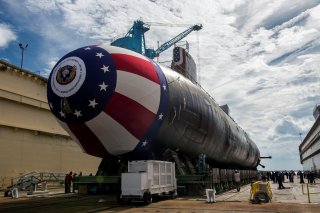See This Submarine? The Navy Wants As Many As they Can.
Following years of deliberation, budget planning and several industrial base assessments, the Navy is now moving to execute an ambitious plan to build as many as three Virginia-class submarines per year.
The U.S. Navy simply can’t build submarines fast enough as it seeks to offset, minimize or even preclude an anticipated attack submarine “deficit” in coming years as more Los Angeles class attack submarines retire. While Virginia-class attack submarines are arriving, with many already here, the Navy has for many years now been working with Congress to increase the pace of production and delivery of the new boats.
Following years of deliberation, budget planning and several industrial base assessments, the Navy is now moving to execute an ambitious plan to build as many as three Virginia-class submarines per year in coming years, and maintain a pace of at least two per years when production of the new Columbia-class submarines revs up at the end of the decade. The need for the submarines is certainly well understood, and numerous extensive assessments have determined that the U.S. industrial base can, in fact, absorb a substantial uptick in attack submarine production and delivery.
There are many reasons for why the Navy continues to have a large and ever-growing demand for new Virginia-class attack submarines, factors which relate to the size and sophistication of the Russian submarine fleet, pace of Chinese new submarine construction and the performance thus far of Virginia-class submarines that are now operational. Attack submarines, and Virginias in particular, are continuously being developed and deployed as “reconnaissance” or “spy” platforms as much as or if not more than attack platforms. The two interconnected missions, which fortify one another on a single platform, are increasingly in demand, because submarines can more easily access and surveil high-threat areas from undersea which larger, more detectable surface ships can struggle to approach. This is particularly true with some now operational and emerging Virginias equipped with new, stealthy quieting technologies and sonar detection systems which enable previously unprecedented possibilities for clandestine reconnaissance operation from beneath the sea in high-risk areas.
However, despite the industry’s apparent ability to flex and expand to accommodate the uptick, there have been some delays due to the coronavirus and some staff-training issues, according to a story from Bloomberg news. These kinds of setbacks are still impacting the ongoing construction of the now-emerging Block V Virginia-class boats, a new, upgraded variant of the platform with massively increased firepower when compared with existing Virginias. Block Vs are being built with a new eighty-foot section called Virginia Payload Modules able to bring the submarine’s ability to carry and fire Tomahawk attack missiles from twelve up to forty. Block V boats are therefore larger, yet also engineered with all the technological attributes known to the Virginia-class submarines to include fly-by-wire navigational controls, fiber-optic sensor camera imaging and a host of cutting-edge quieting technologies.
Kris Osborn is the Defense Editor for the National Interest. Osborn previously served at the Pentagon as a Highly Qualified Expert with the Office of the Assistant Secretary of the Army—Acquisition, Logistics & Technology. Osborn has also worked as an anchor and on-air military specialist at national TV networks. He has appeared as a guest military expert on Fox News, MSNBC, The Military Channel, and The History Channel. He also has a Master's Degree in Comparative Literature from Columbia University.
Image: Reuters.

